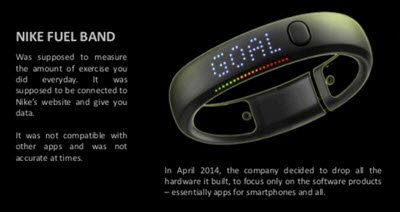With wearable technology gaining momentum after the announcement of Google Glass and Smartwatches, you might want to know the history of the technology morphed. This is not a history of wearable computer ware. Instead, it shows you glimpses from the past in the form of the top 10 failed electronic gadgets. Most of our current wearable gadgets are products of work done on these flopped devices.

Failed Wearable Electronic Gadgets and Devices
The list includes mostly wearable electronic gadgets While we are here, a question: Are wearable gadgets, a health risk?
Is Google Glass a Flop Already? I’ve heard people do not want to wear it while going out as it is inconvenient. Then there are laws to be made regarding its usage in public places and while driving. What is your view on Google Glasses – liked or already a flop? I am not commenting on it yet.
- Pomo Wearable Computer: Nice sleek design; Could perform limited computing less than the smartphones of today; Problem was wires hanging all over the body.
- Nike Fuel Band: Was supposed to measure the amount of exercise you did every day. It was supposed to be connected to Nike’s website and give you data. It was not compatible with other apps and was not accurate at times. In April 2014, the company decided to drop all the hardware it built, to focus only on the software products – essentially apps for smartphones and all.
- Galaxy Gear: Had to be paired with a phone; Not many apps were available to keep people engaged; It is rumored that Galaxy will come up with an advanced version that won’t require phone pairing.
- Bluetooth Headsets: Saw a steep rise when launched But then, pairing problems and not being able to catch other sounds from the mobile phone (audio files) led to decline; With Apple launching its white earbuds, the users of Bluetooth declined very fast.
- Virtual Reality Headsets: This was before the Oculus Rift came in. You can see the heavy headset with wires all over. Images were supposedly not clear; The main reason behind the decline of this device was that Oculus’ products do not rely on wires and are way much lighter than these Virtual Reality Headsets.
- Jawbone UP: The Jawbone UP was a major flop. It was supposed to be tied on the wrist and count your work done (calories burned) However there were problems with syncing. Another major problem was that you could not connect the wristband to the phone without the jack you see in the image. Maybe a future version may bring in a wireless version because the need for connecting via headset makes it old technology.
- Huawei Talkband: This was a combo of Bluetooth headsets that could be worn around the wrist. Was also called SmartBand as it would also inform you about sleep, calories, etc. Had different metal or plastic buttons to tell it that you are starting something, such as going to sleep. Would also work as an alarm by vibrating your wrist until you wake up! Failed as it did not provide accurate data. It missed out on some activities; Users had to use a wired connection to connect to smartphones for obtaining the data.
- Masunaga Wink Glasses: These glasses were for people who forgot to blink while computing. If you don’t blink for a longer time, one of the lenses would fog up to provide relief to that eye. The glasses also have sensors that would notice if you dozed off working on the computer and would wake you up. The Wink Glasses failed to take off due to a lack of proper promotion. Also, the cost was too high, around $300.
- MSN Direct Smartwatch: Though not completely out of the market, the smartwatch from Microsoft was based on Small Personal Objects Technology, also known as SPOT. The smartwatch would connect directly to the Internet to bring you data regarding weather, stocks, etc. Microsoft wanted to charge $60 per month for the services which was too much for the users who turned to smartphones.
- Qualcomm Toq Smartwatch: The reason it flopped was its price… otherwise it is a good device with different types of inputs, especially – voice input; For sending SMS, you could use speech-to-text (Needs a little practice); Besides it would pull up information from Internet based on your voice commands; The company priced it at a high amount of $350; Another reason it flopped is that it supports only Android.
As I mentioned, this is not a comprehensive list. This list of top 10 failed electronic gadgets (wearable) can be increased if you suggest some other gadgets that I missed including here.
Read next: Discontinued Google Products.